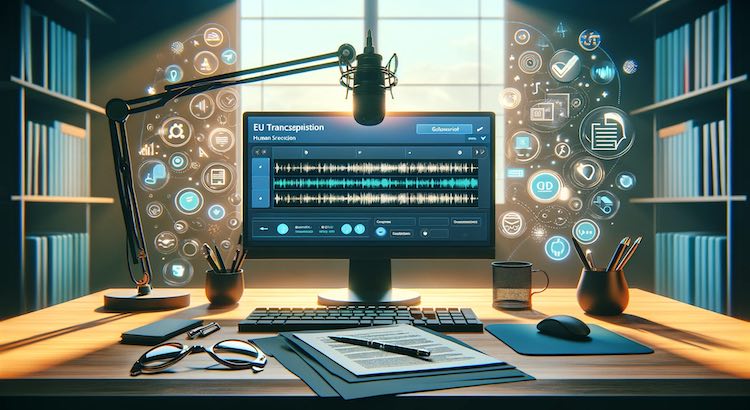EU WCAG 2025 Audio Accessibility Checklist: Make Your Website Compliant
Accessibility is now a top priority in web development. With the new European Union Web Content Accessibility Guidelines (WCAG) 2025, making your audio content compliant is essential. These guidelines ensure people with disabilities can access audio materials on every website, supporting equal access for all.
This guide breaks down the standards, your step-by-step compliance checklist, and how GoTranscript’s human transcription services can help you achieve and maintain accessibility.
What Are EU WCAG 2025 Audio Standards?
The EU WCAG 2025 standards outline what’s needed to make digital audio accessible to everyone, including:
- People who are deaf or hard of hearing
- Users with cognitive or learning disabilities
- Anyone relying on alternative ways to interact with online content
Key requirements include:
- Every audio file must have a text alternative, such as a transcript
- All video content with sound must offer synchronized captions
- Text alternatives should be easy to locate and use
Failing to comply can result in legal action, fines, or a loss of audience trust (European Commission, 2023).
Why Accessibility Matters
- Globally, over 430 million people have disabling hearing loss (World Health Organization, 2021)
- Accessible sites reach more users and improve SEO
- Accessible practices show your business values inclusion
Why Choose GoTranscript for Audio Accessibility?
GoTranscript leads the way in human-based transcription, AI transcription, and captioning services. Human transcription ensures higher accuracy than automated tools, especially for:
- Accents or dialects
- Background noise
- Technical, medical, or legal language
GoTranscript offers:
- Fast turnaround and affordable transcription pricing
- Quality you can trust for legal and WCAG compliance
- Easy online ordering for transcripts and captions
EU WCAG 2025 Audio Content Compliance Checklist
Use this checklist to make sure your website’s audio content meets the latest EU accessibility requirements.
1. Transcribe All Audio Content
- Transcribe every podcast, interview, webinar, and audio clip
- Make transcripts accurate and clear for all users
- Use transcription proofreading for error-free results
2. Add Captions to All Videos
- All videos with sound need captions synchronized with the audio
- Captions help not only hearing-impaired users but also those in noisy environments
- GoTranscript’s closed caption services meet EU and US standards
3. Make Transcripts Easily Accessible
- Place a download link or embed transcripts directly next to your audio or video content
- Ensure compatibility with screen readers and other assistive technology
4. Keep Transcripts and Captions Updated
- If you change an audio file or video, promptly update the corresponding transcript or captions
- Review older files regularly to ensure compliance as guidelines evolve
5. Use Accessible Media Players
- Select audio and video players that support keyboard navigation and screen readers
- Test with current assistive technology to confirm usability (W3C, 2023)
6. Regularly Test Website Accessibility
- Employ accessibility testing tools and request feedback from users with disabilities
- Consult a specialist if you’re unsure about compliance
7. Train Your Team on Accessibility Best Practices
- Teach content creators about the importance of transcripts and captions
- Regularly share updates about evolving accessibility guidelines
Additional Tips for Multi-Language or Global Sites
- If you serve multiple regions, consider text translation services for transcripts
- Use audio translation and subtitling services to reach a larger audience
Frequently Asked Questions (FAQ)
What is the penalty for EU WCAG 2025 non-compliance?
- Non-compliance can result in legal challenges, fines, and mandatory remediation (European Commission, 2023)
Are automated transcripts enough?
- Automated transcripts work well for clear audio, but may miss words with accents, slang, or background noise (Stanford, 2022)
- For best results, use a hybrid AI transcription subscription or rely on verified human transcription
Do I need captions for live streams?
- Yes. Live streams must offer real-time captions or provide an accurate transcript soon after the event
Conclusion: Streamline Compliance with GoTranscript
Meeting EU WCAG 2025 standards for audio content is both a legal and moral responsibility. By ensuring every audio or video file has a clear, accurate transcript or caption, you boost accessibility and allow more people to engage with your site.
GoTranscript specializes in easy, affordable, and reliable solutions for transcription, captioning, and subtitling. Whether you need cost-effective pricing or quick ordering options, GoTranscript can help your website remain fully accessible and compliant under the new EU guidelines.



















 Verified Order
Verified Order